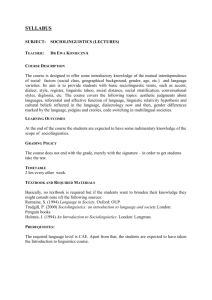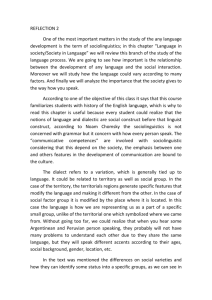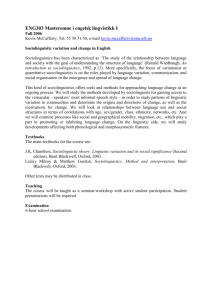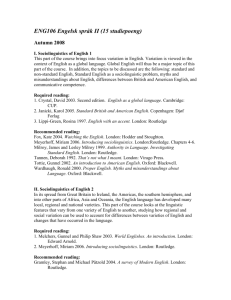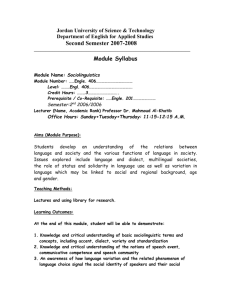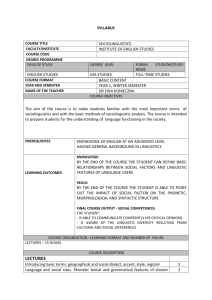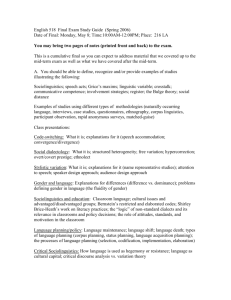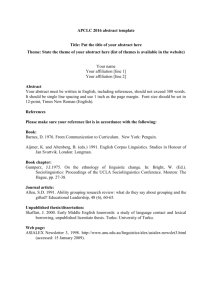sociolinguistics
advertisement
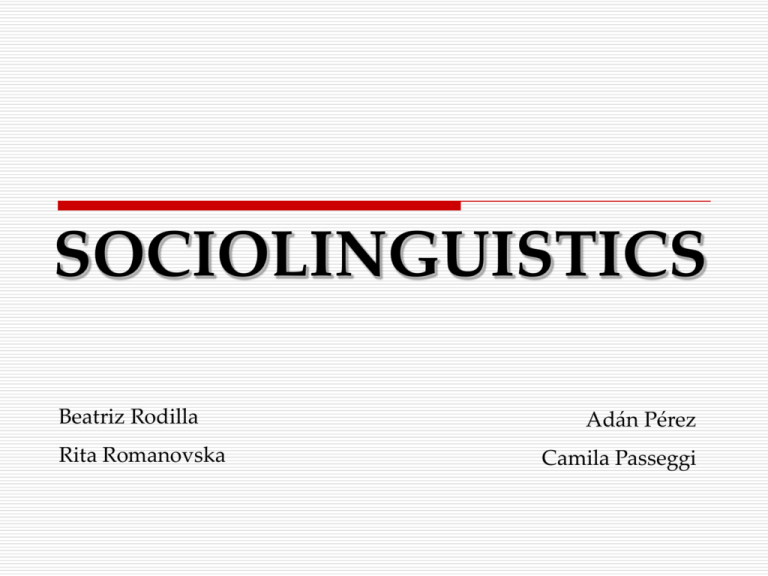
SOCIOLINGUISTICS Beatriz Rodilla Rita Romanovska Adán Pérez Camila Passeggi Definition and Origins Sociolinguistics is the study of the effect of any and all aspects of society on languages [2]. It also studies how language varieties differ between groups separated by certain social variables, e.g., ethnicity, religion, status, gender, level of education, age, etc., and how creation and adherence to these rules is used to categorize individuals in social or socioeconomic classes [2]. As the usage of a language varies from place to place, language usage also varies among social classes, and it is these sociolects that sociolinguistics studies. Sociolinguistics often shows us the humorous realities of human speech and how a dialect of a given language can often describe the age, sex, and social class of the speaker; it codes the social function of a language [2]. The social aspects of language were in the modern sense first studied by Indian and Japanese linguists in the 1930s, and also by Gauchat in Switzerland in the early 1900s, but none received much attention in the West until much later [2]. The study of the social motivation of language change has its foundation in the wave model of the late 19th century [2]. The first attested use of the term sociolinguistics was in 1939. Sociolinguistics in the West first appeared in the 1960s and was pioneered by linguists such as William Labov in the US and Basil Bernstein in the UK [2]. Basic Concepts Speech communities are groups of people of any social class, students, workers or even friends and families. They use the language according to a set of norms to share enough characteristics of pronunciation, grammar, vocabulary [9, 10]. High/low prestige varieties Prestige could be defined as something related with the types of sociolects: + prestige is associated with the language or sociolect of the upper classes; - prestige is associated with the language or sociolect of the lower classes [11]. Social network Another way of describing a particular speech community in terms of relations among its individual members. Tight community: all members of one group interacting with each other. Looser community: little interaction among the members of a group [12]. Internal/external language External language: all that happens among people in social contexts. Internal language: all which happens inside our minds [13]. . Language Change Language change is a phenomenon studied both by historical linguists and sociolinguists. Historical linguists study basically the change of languages over time (diachronic change) and examine how languages were used in the past and how they relate to one another [1]. Eg. Old English Middle English Modern English Sociolinguists study the origins or the causes of language changes and explain how society and changes in speech communities influence language and generate sociolects [1]. Eg. Spanish spoken by an upper class man/woman in Madrid and Spanish spoken by a working class man/woman in Andalucía. Language change is the phenomenon whereby phonetic, morphological, semantic, syntactic, and other features of language vary over time [1]. Language Change Causes Economy The principle of least effort is one of the basic and most used explanations for many language changes [3]. Eg. She + is = she's; we + have + been = we've been; clothes /kloʊðɪz/ - /kloʊz/; fifth /fifθs/ /fifs/. Analogy A linguistic process that reduces words which are perceived as irregular by making them similar to other regular forms [3]. Eg. Semantic historically “livid” meant “pale”, its similar sound with “vivid” has led to analogical semantic change. Morphological the verb “thrive” (thrive-throve-thriven) is on its way to becoming a regular verbs (thrive-thrivedthrived). Language contact Languages come into contact with each other. The most common way that languages influence each other is the exchange of words especially if there is lexical a gap in the language [3]. Eg. “shushi” from Japanese. Or if the donant language is thought to sound more prestigious [3]. Eg. French loans in English in law (“crime”, “judge”) or fashion and food (“mirror”, “mutton”). Language acquisition A psycholinguistic explanation related to the generative theories (N. Chomsky – human beings possess an innate faculty for acquiring language). Language acquisition by children is considered the main origin of language change because the child’s inner grammar may differ from the adult’s. Yet, it has been demonstrated that language change is not restricted to language acquisition, but may also occur with adult speakers [3]. Sociolinguistic explanations It is assumed that we can infer how a language will vary over time if we analize the linguistic behaviour of different age groups at a certain point in time. W. Labov. stated that two decisive parameters influence speakers´ linguistic behavior: their social class membership and the formality of the situation [3]. Language Change Types Language is always changing: pronunciations evolve, new words are borrowed or invented, the meaning of old words drifts, and morphology develops or decays. There are three major types of language change: lexical, grammatical and sound level. Lexical level refers to changes in the meaning of words: 1- Loss Lexical Items – same phonemic structure but different meaning [6]. Eg.”Bank”; or phonetic attrition ”refrigerator” -”fridge”. Lexical level 2- Change of meaning – semantic change due to historical or psychological factors [6]. 3- Creation of new lexical items [6]. Eg. External from French words - “crown”, “power”. Internal: “bird” as “girl” from “bride”. Grammatical level refers to the change in grammar and vocabulary. In this process, morphs, combinations of morphs or linguistic patterns are modified [7]. 1- Morphological change: languages as analogy. Eg. Middle English plural from ”cow” was “kine “; Modern English: cow/cows; bull/bulls. 2- Syntactic change: lexical words increasingly adopt a grammatical function. Eg. “Will” meant “want”. Sound level describes the passage of historical transition from a given phoneme or group of phonemes to another [5]. Eg. The change of Germanic /sk/ into Old English /sh/. Sound level 1- Phonetic change: affects the manner of articulation [4]. -Influence of neighboring sounds. Eg. From /y/ (“mýs”) in Old English to /i:/(“mice”) in Modern English. -Apocope: omission of some vowels from the end of a word. Eg.“Child” as “Chile”. Sound level 2- Phonemic change: affects the pronunciation or sound system structures [4]. Eg. /з:/ (as in “meat” or “read”) or /e:/ (as in “meet” or “reed”). Conclusion 1. Sociolinguistics is a science which studies the effects of the society on languages. 2. Classification of the origins of the language change (economy, analogy, contact) and related theories (Chomsky, Labov). 3.Focus on how these changes happen at different levels of language structures over time (lexicon, grammar, sounds). References 1. http://en.wikipedia.org/wiki/Language_change 2. http://en.wikipedia.org/wiki/Sociolinguistics 3. Torres Aguilar, I. (2009). Language Change: A General Overview. 4. National Institute for Literacy (2001). 5. Thomas Pyles and Jonh Algeo (1982). The origins and development of the English language. Hacourt. 6. Language Variation and Change, 1 (1989). Cambridge University. 7. Kroch, Anthony (1989b). Reflexes of grammar in patterns of language change. Language Variation and Change 1:199-244. 8. Schendl, H. (2001). Historical Linguistics. Oxford: Oxford University Press. 9. http://en.wikipedia.org/wiki/Speech_community 10. http://grammar.about.com/od/rs/g/speechcommunityterm.htm 11. http://en.wikipedia.org/wiki/Prestige_(sociolinguistics) 12. http://en.wikipedia.org/wiki/Sociolinguistics#Social_network 13. http://www.enotes.com/unlocking-english-language/q-and-a/what-internalexternal-aspects-english-language-93529 SOCIOLINGUISTICS

